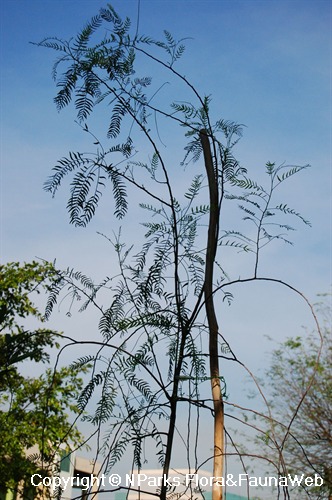
Name
Classifications and Characteristics
| Plant Division | Angiosperms (Flowering Seed Plants) (Dicotyledon) |
|---|---|
| Plant Growth Form | Tree (Small (6m-15m)) |
| Maximum Height | 8 m to 15 m |
| Maximum Plant Spread / Crown Width | 8 m |
Biogeography
| Native Distribution | Argentina, Bolivia, Brazil, Chile, Ecuador, Paraguay, Peru, Uruguay |
|---|
Description and Ethnobotany
| Others - Plant Morphology | Growth Form: Large shrub or small evergreen tree with weeping habit. Habitat: Occurs on dry, sandy soil in coastal areas or valleys. Naturally found at altitudes from 0 – 2000 m, but can be cultivated at > 3000 m. In Australia, Hawaii and South Africa, this tree is considered an invasive plant that poses a serious threat. Trunk: Smooth bark is mostly grey with some patches of dark brown. Lenticels (corky structures that allow oxygen to pass into the trunk) are round and orange-brown. Foliage: Leaves pinnately compound (10 - 20 cm long) with 10 - 20 pairs of lanceolate leaflets. Leaves contain a high concentration of aromatic oils and produce a pine-like scent when crushed. The topside of leaves is green, while the underside is whitish. Flowers: Flowers white or cream with yellow centers are arranged in branched inflorescences classified as terminal or axillary panicles. Terminal panicles occur at the end of branches while axillary ones are further in, towards the middle. Fruits: Each plant produces large numbers of dark pink, round fruits classified as drupes (5 - 7 mm in diameter). Drupes are fleshy fruits that contain a hard pit holding a single seed, such as cherries. Fruits are edible, having a sweet taste similar to licorice. Fruits are consumed by birds. Landscaping: Commonly planted in Mediterranean countries as an ornamental tree, because the tree produces an abundance of attractive, long-lasting pink fruits. This tree would be ideal for dry locations. The roots spread along the surface of the ground, potentially damaging nearby pavement, drains, and house foundations. Branches may become hollow during a prolonged drought and may be broken by a strong wind. Cultivation: Plant in well-drained, slightly acidic sandy loam or clay loam (pH = 5.5 – 6.5). Susceptible to attack by the Pink Hibiscus Mealybug (Maconellicoccus hirsutus). Propagation: Propagate by seed or re-planting the suckers. Etymology: The genus name “Schinus” comes from the Greek word “schinos” which is the name of a Mediterranean tree that produces valuable aromatic resins (Pistacia lentiscus). The species epithet “molle” is derived from “molli”, the plant’s common name in Quechua. |
|---|---|
| Ethnobotanical Uses | Food (Herb or Spice) Others: Food: In the tropics, dried berries are grinded to make a pepper-like seasoning for food. The Incas concocted alcoholic and non-alcoholic beverages from the fruits. In Chile, the fruits are used to flavor some types of wine. Medicine: The essential oil in the leaves has antimicrobial and antifungal activity (Gundidza 1993). In traditional medicine, extracts were used to heal a variety of disorders, such as depression, menstrual disorders, toothaches and rheumatism. They were also used to heal wounds. Other: Leaf and fruit extracts effectively repel Triatoma infestans larva, an important insect vector of the lethal Chagas’ disease (Ferrero et al 2006). Fruit extracts can also kill T. infestans eggs. The tree is planted as a windbreak and helps to prevent soil erosion. Farmers plant the tree to improve soil conditions, because it adds nutrients and organic matter to the soil. The tree produces a variety of useful products, such as ink, fuelwood, and oils that are added to perfumes. |
Landscaping Features
| Desirable Plant Features | Ornamental Foliage |
|---|---|
| Landscape Uses | Coastal |
Fauna, Pollination and Dispersal
| Fauna Pollination Dispersal Associated Fauna | Butterfly Host Plant |
|---|
Plant Care and Propagation
| Light Preference | Full Sun |
|---|---|
| Water Preference | Little Water |
| Plant Growth Rate | Moderate |
| Rootzone Tolerance | Drought Tolerant, Saline Soils / Salt Spray |
Image Repository
Others
| Master ID | 30373 |
|---|---|
| Species ID | 4682 |
| Flora Disclaimer | The information in this website has been compiled from reliable sources, such as reference works on medicinal plants. It is not a substitute for medical advice or treatment and NParks does not purport to provide any medical advice. Readers should always consult his/her physician before using or consuming a plant for medicinal purposes. |

